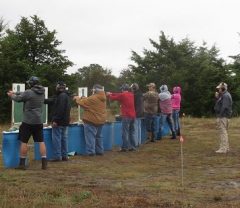As of this writing, there are just over 1,000,000 Texans who have a License to Carry (formerly Concealed Handgun License). It is not known how many of them carry a firearm daily. Of those that do, some of them carry a full-size handgun, like a 1911, Glock 17, or CZ 75, but most people probably carry something more concealable, especially women. Manufacturers use different terms to describe their products, like compact, sub-compact, or micro-pistol, and everyone has a different opinion about what constitutes a “concealable” pistol, but the handguns typically in use as a carry gun can range from moderately large (Glock 19, CZ 75 Compact) to tiny (Ruger LCP .380, S&W Bodyguard .380, Beretta Bobcat .32 or .22).
As a general rule, the bigger the gun, the easier it is to handle and shoot. The longer it is, the easier it is for accuracy at 10 yards. According to the FBI, most self-defense happens at 5 yards or less, so even a person with limited skills can probably save their life with a small or tiny gun, right?
Doubtful. That does not take into account the Panic Factor. In a true emergency, due to physiological changes to the body brought on by fear, people will typically lose half of their skills. This also happens to police officers, who typically miss their target 75% of the time. This is not a knock on police, as their is no training that will solve that problem. There are ways to mitigate those effects, but the best solution is to simply set a higher standard for yourself. Police officers sometimes come to me for training, not because I know tricks that their trainers don’t know, but because they can progress faster in a 1-on-1 session than they can on a firing line with 29 other people firing.
Add to that the fact that carry guns are often not much fun to shoot. People often get in the habit of carrying a gun they can slip in a pocket, but go to a range and practice with a Glock 40 (large 10mm bear gun) or 1911 .45. The theory is that one can develop skills with a bigger gun, and apply those skills to a tiny gun for up close and personal events. I don’t disagree with that, but at some point, you need to face the fact that you may need more skills with that little gun than you possess. Can you draw from concealment and hit the Bad Guy with one shot at 10 yards, in 3 seconds? Without a warm-up?
My suggestion: train with your carry gun. Go online and print out some drills, ranging from easy to quite challenging. I like the Winchester Series of self-graded skills tests, the FBI Agent Qualification, and the 5×5 Handgun Skills Test (IDPA). Before trying these, use the Texas LTC Proficiency. When that is easy, do it one-handed. Then do it with the support hand. Some of these call for special targets, but you can find those online. If they call for drawing from a holster, and your local range doesn’t allow that (most don’t), then start from low ready, or from the mid-stroke of the draw.
In all cases, you probably won’t do as well as you good with a bigger gun. The point is, can you do well enough to save your life in a parking garage? That is the goal. Fun has nothing to do with it.
